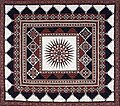|
Trapunto quilting  Trapunto, from the Italian for "to quilt", is a method of quilting that is also called "stuffed technique". A puffy, decorative feature, trapunto utilizes at least two layers, the underside of which is slit and padded, producing a raised surface on the quilt. HistoryThe style originated in Italy before the 14th century.[2] TechniqueTrapunto is often confused with the relatively similar techniques used in making traditional whole cloth Provençal quilts that were developed from the 17th century onwards in France.[3] EarliestOne of the earliest surviving examples of trapunto quilting is the Tristan Quilt in the Victoria and Albert Museum, a linen quilt representing scenes from the story of Tristan and Isolde which was made in Sicily during the second half of the 13th century.[4] Another piece of the Tristan Quilt, thought to be from a pair to the V. & A.'s example, is in Palazzo Davanzati in Florence.[4]
ModernThe technique was used for the inner-tunic collars worn in Starfleet uniforms from Star Trek II: The Wrath of Khan. As of the 1980s, functional trapunto machines were rare, and the specialized needles which they employed were even rarer.[citation needed] References
External links
|
